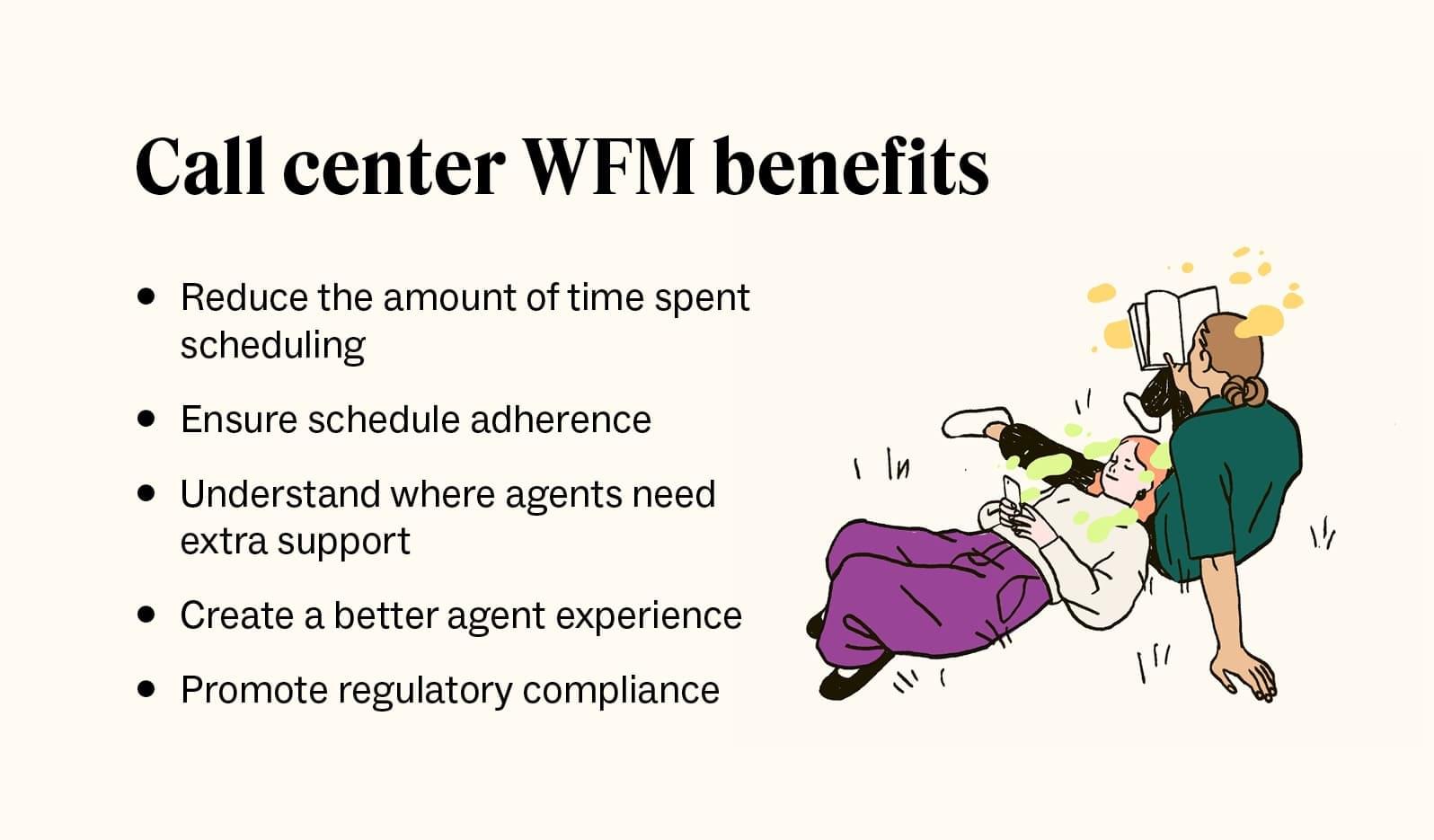Article • 5 min read
What is call center workforce management?
In a call center, workforce management is a set of processes used to optimize productivity and reduce risk. Learn why this is so important in our guide.
Von Hannah Wren, Staff Writer
Zuletzt aktualisiert: September 20, 2024
If you’ve ever worked in a restaurant, you know that working on Friday night is not the same as working on Tuesday afternoon.
Guests and to-go orders come in droves on the weekend, turning dinner rushes into a whirlwind of sensory overload. But, when well-managed, the staff survives the rush time after time—and you can say the same for support teams.
Call centers can be just as hectic (and efficient) as a restaurant on the weekend. But if an organization doesn’t have enough agents during peak hours, customers can easily become frustrated.
Call center workforce management (WFM) is the solution that can help organizations forecast staffing needs, manage payroll, deliver an outstanding customer experience (CX), and more. Read on to learn how to thrive through your organizational dinner rushes with WFM.
- Why is call center workforce management important?
- Key features of call center workforce management
- 5 benefits of workforce management for call centers
- Streamline your call center with Zendesk WFM
Why is call center workforce management important?
Call center workforce management is important because it streamlines employee scheduling, time tracking, and future planning—all while optimizing productivity and reducing risk across the board.
Timely, accurate service has never been more important for an organization. In fact, according to the Zendesk Customer Experience Trends Report 2024, 72 percent of customers want immediate service—meaning businesses must prioritize getting their audience the support they need as quickly as possible. This is where workforce management can help.
With a successful call center WFM strategy, businesses can optimize staffing needs for consistently positive customer support. Not only that, but WFM can assist with managing payroll and workflows, developing short- and long-term goals, and creating a better work environment for employees.
Key features of call center workforce management
Every business can have its own spin on call center workforce management. That said, there are a few key components that every WFM strategy should have.

Staff forecasting and scheduling
Businesses need to ensure they have the right amount of employees at the right time to maximize budgets and productivity. Customer trends, seasonality, business demands, and more can all throw a wrench in scheduling, leading to periods of understaffing or overstaffing.
With call center workforce management, companies can maintain efficient scheduling and accurate labor forecasting by leveraging historical data to create future schedules—plus, this benefit compounds if using other helpful call center platforms like interactive voice response (IVR) software.
Time and attendance tracking
Time and attendance tracking represents the hours worked, productivity, and scheduled absences. Proper tracking—like ensuring employees are accurately logging their time and daily activities—can aid in optimizing payroll budgets, reducing operational costs, and decreasing an organization’s bottom line. This, combined with other processes that improve efficiency, like call center scripts, can aid employees in being as productive as possible.
Real-time team management
Modern workforce management software can give an organization real-time insight into the status of its employees. With this setup, managers can check in on workers throughout the day, seeing where they spend their time—a process that can lead to opportunities for training and development. Furthermore, real-time team management can also make a difference when customer demand unexpectedly rises during the day, allowing managers to allocate staff where and when needed.
Reporting and analytics
Data reporting and analytics transform business operations. With call center WFM reports, managers can gain insight into company metrics and employee performance and merge this data with statistics from other platforms like call center software.
Businesses can use this data for many organizational decisions like scheduling, training needs, intraday management, and future operations planning.
5 benefits of workforce management for call centers
Call center workforce management can offer several benefits to an organization—even more so when you use advanced platforms like Zendesk WFM. Such tools like Tymeshift can offer insights into agent activities, agent scheduling, service levels, staffing levels, and more to make WFM that much easier.
Here are a few ways WFM can benefit a call center.

1. Reduce the amount of time spent scheduling
With workforce management software, call centers can automate the scheduling process and reduce admin time. Software like Zendesk WFM can generate optimized schedules instantly by factoring in staffing and call volume forecasts, agent availability, and business needs, saving a tremendous amount of time compared to working from a spreadsheet.
Furthermore, managers can access custom dashboards to keep an eye on the little details like scheduled breaks, lunches, and tasks to plan for any gaps in coverage. With automated scheduling, businesses can create efficient schedules that don’t overwork employees, allowing for high employee satisfaction rates.
2. Ensure schedule adherence
Schedules are paramount in a hectic environment like call centers. WFM processes can empower managers to monitor and enforce employee schedules to ensure agents stay on track. It also allows managers to adjust quickly when schedules don’t go as planned.
Ensuring employee schedule adherence means that contact center operations maintain efficiency, call queues don’t become overwhelming, and employees develop call center skills, all while maximizing labor costs.
3. Understand where agents need extra support
With WFM processes, businesses can identify opportunities to implement call center training tips and pinpoint areas where employees struggle or fall behind. Doing so can lead to training opportunities that improve agent skill sets.
Managers can monitor organizational customer experience key performance indicators (KPIs)—things like first response time and first call resolution—for a glimpse into operation and agent performance. By identifying any gaps in agent efficiency and then implementing the necessary support or training modules, managers can increase the productivity and confidence of their team.
4. Create a better agent experience
Workforce management isn’t solely for customer needs—it should also create a better employee experience. Zendesk WFM allows support managers to effortlessly sync their Zendesk data and manage agents’ schedules through custom dashboards and automatic time tracking. WFM tracking can also highlight agent successes, encouraging them to take accountability for their work and, hopefully, feel more fulfilled in their roles.
5. Promote regulatory compliance
Being vigilant about local and federal labor laws is important to avoid potential legal issues. Workforce management systems can help organizations minimize compliance risks by automatically keeping track of time cards, overtime, PTO, and other important labor figures.
Streamline your call center with Zendesk WFM
Every day is different for support teams, and businesses need to survive their organizational dinner rush whether guests have reservations or walk-ins. Ensure you have a call center workforce management solution to support you through uncertainty and optimize your operations for today and tomorrow.
Zendesk WFM allows organizations to manage and optimize the performance of their service teams by delivering AI-powered demand forecasting as well as automatic scheduling, to ensure teams are always equipped with the right number of agents for any given season.
Contact sales today.
